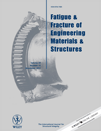Face/core interface fracture characterization of mixed mode bending sandwich specimens
ABSTRACT
Debonding of the core from the face sheets is a critical failure mode in sandwich structures. This paper presents an experimental study on face/core debond fracture of foam core sandwich specimens under a wide range of mixed mode loading conditions. Sandwich beams with E-glass fibre face sheets and PVC H45, H100 and H250 foam core materials were evaluated. A methodology to perform precracking on fracture specimens in order to achieve a sharp and representative crack front is outlined. The mixed mode loading was controlled in the mixed mode bending (MMB) test rig by changing the loading application point (lever arm distance). Finite element analysis was performed to determine the mode-mixity at the crack tip. The results showed that the face/core interface fracture toughness increased with increased mode II loading. Post failure analysis of the fractured specimens revealed that the crack path depends on the mode-mixity at the crack tip, face sheet properties and core density.




